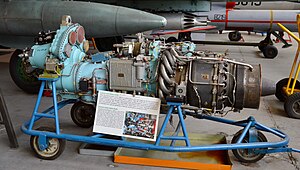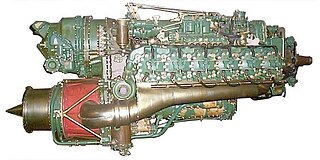
The Napier Nomad is a British diesel aircraft engine designed and built by Napier & Son in 1949. They combined a piston engine with a turbine to recover energy from the exhaust and thereby improve fuel economy. Two versions were tested, the complex Nomad I which used two propellers, each driven by the mechanically independent stages, and the Nomad II, using the turbo-compound principle, coupled the two parts to drive a single propeller. The Nomad II had the lowest specific fuel consumption figures seen up to that time. Despite this the Nomad project was cancelled in 1955 having spent £5.1 million on development, as most interest had passed to turboprop designs.

The Pratt & Whitney Canada PW100 aircraft engine family is a series of 1,800 to 5,000 shaft horsepower turboprops manufactured by Pratt & Whitney Canada. Pratt & Whitney Canada dominates the turboprops market with 89% of the turboprop regional airliner installed base in 2016, leading GE Aviation and Allison Engine Company.

The Pratt & Whitney J75 is an axial-flow turbojet engine first flown in 1955. A two-spool design in the 17,000 lbf (76 kN) thrust class, the J75 was essentially the bigger brother of the Pratt & Whitney J57 (JT3C). It was known in civilian service as the JT4A, and in a variety of stationary roles as the GG4 and FT4.
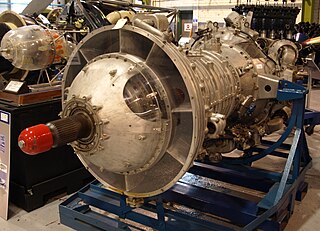
The Rolls-Royce RB.39 Clyde was Rolls-Royce's first purpose-designed turboprop engine and the first turboprop engine to pass its civil and military type-tests.

The Tumansky R-11 is a Soviet Cold War-era turbojet engine.

The Bristol Orion aero engine is a two-shaft turboprop intended for use in later marks of the Bristol Britannia and the Canadair CL-44. Although the engine was built and underwent a development program, the BE.25 Orion project was cancelled in 1958 by the British Ministry of Supply in favour of the Rolls-Royce Tyne. In addition, interest in turboprop-powered aircraft was beginning to wane, because of the successful introduction of the Boeing 707 and Douglas DC-8 jetliners into airline service.
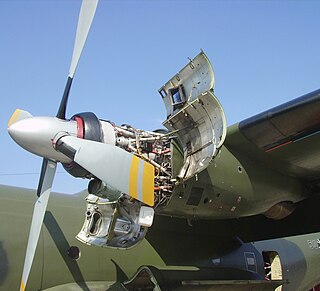
The Rolls-Royce RB.109 Tyne is a twin-shaft turboprop engine developed in the mid to late 1950s by Rolls-Royce Limited to a requirement for the Vickers Vanguard airliner. It was first test flown during 1956 in the nose of a modified Avro Lincoln. Following company naming convention for gas turbine engines this turboprop design was named after the River Tyne.
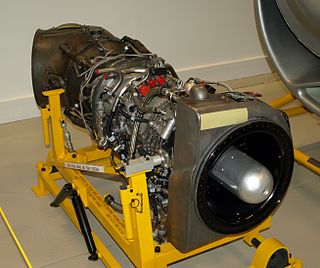
The Rolls-Royce Gnome is a British turboshaft engine originally developed by the de Havilland Engine Company as a licence-built General Electric T58, an American mid-1950s design. The Gnome came to Rolls-Royce after their takeover of Bristol Siddeley in 1968, Bristol having absorbed de Havilland Engines Limited in 1961.

The Rolls-Royce RB.401 was a British two-spool business jet engine which Rolls-Royce started to develop in the mid-1970s as a replacement for the Viper. RB.401-06 prototype engines were already being manufactured when a decision to develop the higher thrust RB.401-07 was taken.
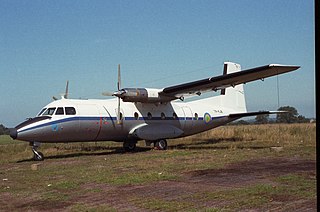
The Turbomeca Bastan was a turboprop engine developed in France in 1957. Early models developed 650 shp (485 kW), but by 1965 this had been increased to 1,048 shp (780 kW) with the Bastan VII.

The Turbomeca Astazou is a highly successful series of turboprop and turboshaft engines, first run in 1957. The original version weighed 110 kg (243 lb) and developed 240 kW (320 shp) at 40,000 rpm. It was admitted for aviation service on May 29, 1961, after a 150-hour test run. The main developing engineer was G. Sporer. It was named after two summits of the Pyrenees.
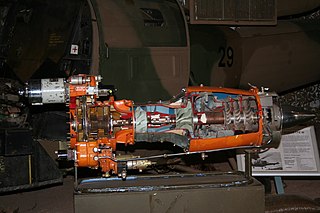
The Turbomeca Artouste is an early French turboshaft engine, first run in 1947. Originally conceived as an auxiliary power unit (APU), it was soon adapted to aircraft propulsion, and found a niche as a powerplant for turboshaft-driven helicopters in the 1950s. Artoustes were licence-built by Bristol Siddeley in the UK, Hindustan Aeronautics Limited in India, and developed by Continental CAE in the US as the Continental T51. Two major versions of the Artouste were produced. The Artouste II family, mainly used in the Aérospatiale Alouette II helicopter, had a one-stage centrifugal compressor and a two-stage turbine, with gearbox-limited power of 300 kW (400 hp). The Artouste III family, mainly used in Aérospatiale's Alouette III and Lama helicopters, had a two-stage axial-centrifugal compressor and a three-stage turbine, with gearbox-limited power of 420–440 kW (560–590 hp).

The Turbomeca Turmo is a family of French turboshaft engines manufacturered for helicopter use. Developed from the earlier Turbomeca Artouste, later versions delivered up to 1,300 kW (1,700 shp). A turboprop version was developed for use with the Bréguet 941 transport aircraft.

The General Electric T64 is a free-turbine turboshaft engine that was originally developed for use on helicopters, but which was later used on fixed-wing aircraft as well. General Electric introduced the engine in 1964. The original engine design included technical innovations such as corrosion resistant and high-temperature coatings. The engine features a high overall pressure ratio, yielding a low specific fuel consumption for its time. Although the compressor is all-axial, like the earlier General Electric T58, the power turbine shaft is coaxial with the HP shaft and delivers power to the front of the engine, not rearwards. Fourteen compressor stages are required to deliver the required overall pressure ratio. Compressor handling is facilitated by 4 rows of variable stators. Unlike the T58, the power turbine has 2 stages.
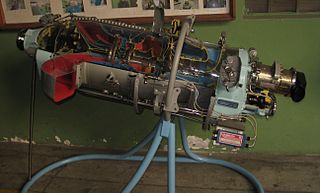
The Walter M601 is a turboprop aircraft engine produced by Walter Aircraft Engines of the Czech Republic. The company's first turboprop, the M601 is used in business, agricultural and military training aircraft.

The General Electric T31 was the first turboprop engine designed and built in the United States.
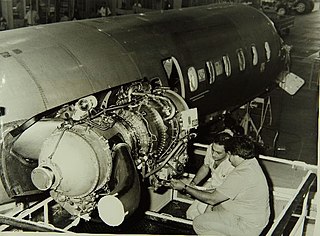
The Garrett TPF351 is a turboprop engine designed by Garrett Engine Division of AlliedSignal Aerospace Company. Initiated by Garrett in October 1987, the TPF351-20 engine was selected by Embraer to power the Embraer/FMA CBA 123 Vector, a high-speed commuter "pusher" aircraft. It was first tested on May 19, 1989 and then ground tested and flight tested on a Boeing 720 on July 9, 1990. The first prototype CBA 123 was tested on July 18, 1990, followed by a flight to the Farnborough Air Show in September of the same year. Both programs were cancelled in 1992, when the TPF351 was nine months from engine certification.

The Boeing T50 was a small turboshaft engine produced by Boeing. It was the first turboshaft engine to ever power a helicopter: a modified Kaman K-225 in 1951. Based on Boeing's earlier Model 500 gas generator, the T50's main application was in the QH-50 DASH helicopter drone of the 1950s. An up-rated version designated Model 550 was developed to power the QH-50D and was given the military designation T50-BO-12.
The Boeing T60 was a family of small turboshaft/turboprop engines produced by Boeing, based on Boeing's earlier Model 500 gas generator and Model 502 (T50) turboshaft engines.
The Northrop-Hendy T37 Turbodyne was an American turboprop engine developed by the Turbodyne Division of Northrop in the late 1940s.
